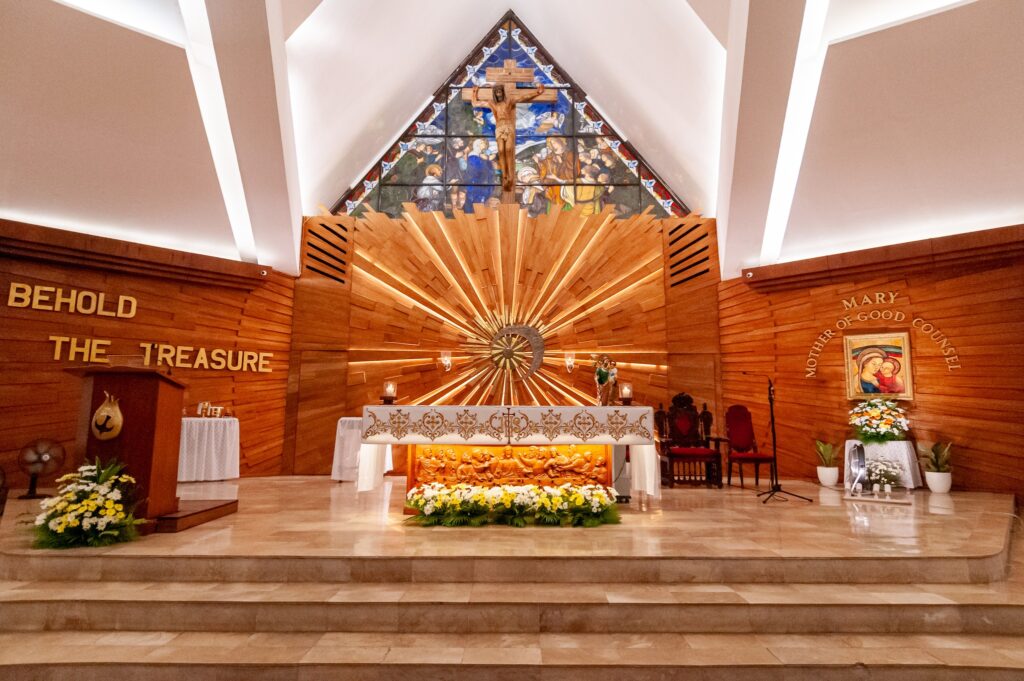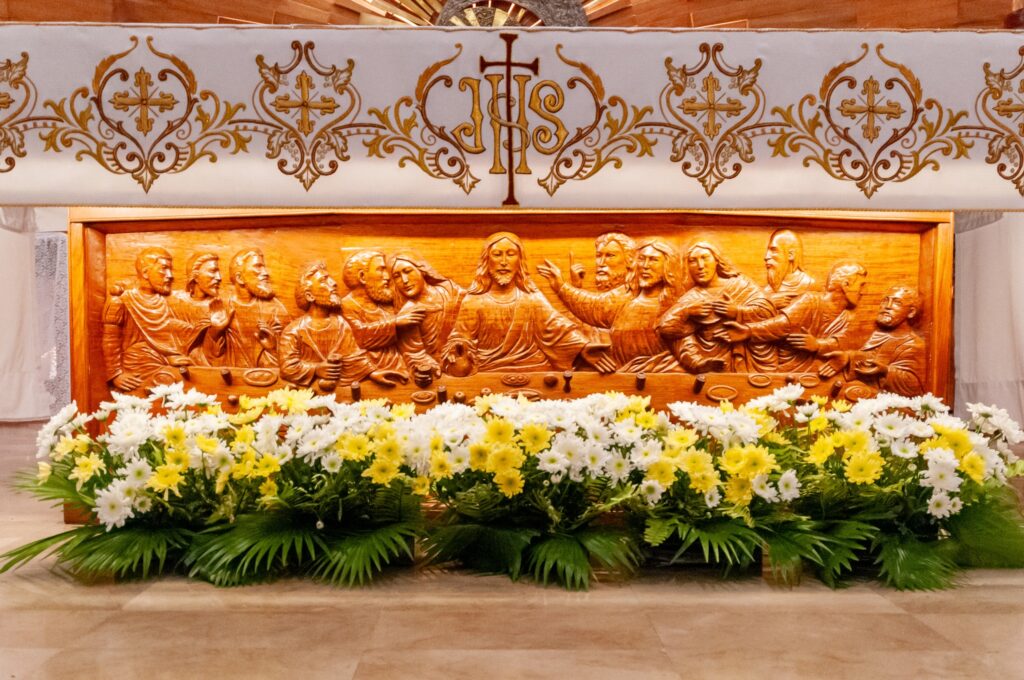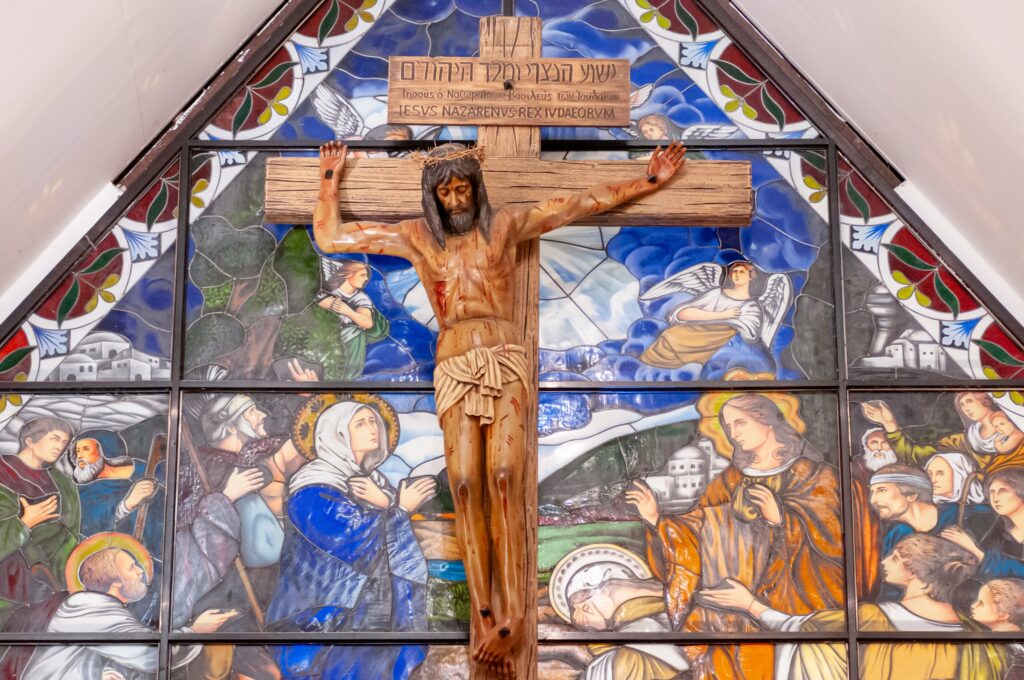The Sacred Space
Dedicated on October 5, 1986, the parish church stands on a 2,000-square-meter lot along Peach Street in Marcelo Green Village. Designed by Architect Pablo Antonio Jr., the fully air-conditioned church accommodates about 360 worshippers, with ample provisions for additional mass-goers outside its main structure.
Hexagonal in form, the church reveals a thoughtful design that draws the eye and heart toward the sacred. From the main entrance, a clear axis leads through the nave to the sanctuary — a visual and spiritual path inviting the faithful into deeper communion with God.
On the left and right sides of the assembly area stand the choir and the confessional, each holding a distinct place in the rhythm of worship. The choir, facing the sanctuary, joins its voices to the prayer of the entire assembly — a living harmony that uplifts hearts toward God. Across from it, the confessional offers a sacred space of mercy, where the penitent meets the Lord of compassion in the quiet grace of reconciliation.
Encircling the worship space are the Stations of the Cross, sacred icons that accompany the faithful in contemplating the mystery of Christ’s Passion. The pews, crafted from native narra wood, speak of simplicity and strength — the faithful gathered as one body, rooted in the soil of their own land.
Near the altar, on the left side, stands the two-level baptismal font, a place of profound symbolism and dignity. Located close to both the ambo and the altar, it signifies the deep unity between Baptism and the Eucharist — the beginning and the summit of Christian life. Here, in the waters of rebirth, the catechumen dies with Christ and rises with Him to new life. What was once a symbol of death becomes a vessel of divine promise — the fountain where grace flows and faith begins.

The sanctuary, raised above the assembly, lifts both sight and spirit toward the heart of the sacred mystery. From this vantage, the faithful behold the unfolding of the liturgy — the sacred dialogue between God and His people. Here, attention is drawn to the three focal points of worship: the presider’s chair, where Christ’s priestly presence gathers His flock; the ambo, where the Word of God is proclaimed and received; and the altar, where heaven touches earth in the Eucharistic sacrifice.
The altar stands as the most sacred point of the church — the table of the Lord, the center of thanksgiving and communion. Fashioned from wood and graced with the depiction of the Last Supper, it recalls the night when Christ gave Himself to His disciples in the gift of His Body and Blood. It is both altar and table — a place of sacrifice and of shared meal, where the faithful are nourished with divine life.
During every celebration of the sacred liturgy, the altar is shown reverence: the priest kisses it in love and veneration, ministers bow before it, and clouds of incense rise to honor the presence of the Lord. Upon this table of grace, the mystery of salvation is renewed — the offering of Christ made present for His people, uniting earth with heaven in a single act of worship and love.


Near the altar stands the presider’s chair, a symbol of the priest’s sacred ministry in leading the assembly in prayer. From this seat, the presider gathers the people of God into one voice of praise and thanksgiving. The chair itself signifies not personal honor, but the dignity of the priestly office — the visible sign of Christ who presides over His Church. Distinct from the other seats in the sanctuary, it reminds the faithful that the priest acts in persona Christi, guiding the community in worship and service.
The ambo, made of wood like the altar, stands firm and permanent — the table of the Word. From this place, the Scriptures are proclaimed, the homily is preached, and the General Intercessions are offered. Fronting the ambo is the figure of the Holy Spirit, who enlightens minds and hearts, opening them to receive the Word with faith. As light streams toward this sacred stand, it recalls the Spirit’s eternal role: to breathe life into the Word and awaken understanding in those who listen.
At the very heart of the sanctuary stands the tabernacle, the dwelling place of the Lord. Crafted with reverent care, it serves as both a throne and a home — a visible sign of the invisible mystery of Christ’s abiding presence among His people. Its central position reminds the faithful that the Eucharist is the source and summit of Christian life, the wellspring from which all grace flows.
The design of the tabernacle invites contemplation. Its form, radiant and firm, mirrors both majesty and mercy: a vessel of gold and light where heaven seems to rest upon earth. Around it, a burst of golden rays extends outward across the sanctuary wall, symbolizing the outpouring of divine love — Christ who is Light from Light, shining into every corner of human life.
Before this sacred dwelling, a sanctuary lamp burns without ceasing, a silent witness to the Lord who remains among us. In its gentle flame, the heart recognizes the warmth of Emmanuel — God with us. Here, the faithful come to pray, to adore, to rest in the stillness of His presence.
The tabernacle is not merely a fixture of beauty; it is a mystery of communion. Within its silence, the Bread of Life waits — humble, hidden, yet wholly divine — drawing every heart that believes toward the radiant center of love itself.

Dominating the sanctuary with solemn grace is the Sindonic Crucifix, a masterpiece sculpted by artist Ian Vicente. Raised high above the altar, it draws every gaze heavenward, inviting deep contemplation of the mystery of Christ’s Passion.
The six-foot corpus, modeled on the sacred imprint of the Shroud of Turin, bears the silent testimony of suffering redeemed by love. Nails pierce the wrists and feet; the right side of the face, bruised and swollen, recalls the broken cheekbone of the Crucified One. Each wound is rendered with reverent realism — traces of the Roman scourges that tore His flesh, yet from which the light of salvation shines.
Above the head of the Savior rests the titulum, inscribed first in Hebrew, then translated into Greek and Latin, proclaiming before all nations: Jesus of Nazareth, King of the Jews.
Suspended in stillness yet alive with meaning, the Sindonic Crucifix stands as the heart of the sanctuary — the axis of mercy and the summit of faith. In its shadow, worship becomes encounter, and the faithful behold not merely a figure of pain, but the radiant image of love that redeems the world.

On the right wall of the sanctuary rests the icon of our patroness, Mary, Mother of Good Counsel, patterned after the venerated image enshrined in Genazzano, Italy. Her serene face and tender gaze seem to gather the light that filters through the stained glass, diffusing it with a quiet radiance that enfolds the whole sanctuary in peace.

Mary is invoked as Mother of Good Counsel because she embodies the Lady Wisdom of Scripture — the woman filled with the Spirit of understanding, whose every thought and word reflect divine discernment. The same Spirit who overshadowed her now breathes through this sacred space, sanctifying all who come to listen, to pray, to seek direction.
In her maternal presence, the church’s interior finds its gentle rhythm of grace. The altar where the mystery of love is renewed, the tabernacle where the Lord abides, the Sindonic Crucifix lifted in silent agony, and the stained glass that filters the light of heaven — all seem to converge toward her, as if drawn by her quiet intercession.
Those who lift their eyes to her image find more than a figure of beauty; they find a mirror of divine wisdom, guiding every heart toward her Son. Here, the faithful learn what true counsel is: to listen in faith, to ponder in silence, and to follow the will of God with joy. In the Mother of Good Counsel, the entire church finds its soul — luminous, tranquil, and wholly turned toward Christ.
The building we call Mary, Mother of Good Counsel Parish Church is both the house of God on earth (domus Dei) and the house of the Church (domus ecclesiae) — the dwelling place of the Divine and the home of His people. The walls may rise in stone and wood, yet it is the living community of faith that gives them breath and meaning.
This sacred house is not merely a place of gathering, but a visible sign of the Church alive in this corner of the world — a reflection of the pilgrim Church journeying on earth, and an image of the heavenly Church that awaits in glory.
Every church, and ours most especially, stands as a place of encounter, where heaven leans close to earth, and the mystery of God’s presence unfolds in word, in sacrament, in silence, and in song.
Here, we are reminded of the God who chose to dwell among us — whose nearness we touch, yet whose greatness remains beyond all measure. This is our home of faith and love, the dwelling we call Mary, Mother of Good Counsel Parish Church — a meeting place between the human and the divine, between the now and the eternal.


